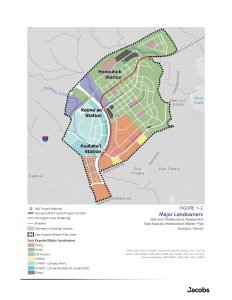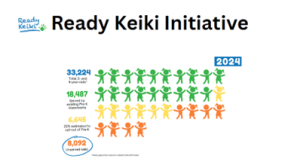State Transit-Oriented Development Program
WHAT’S NEW!
Pāhoa Transit Hub and Library Project Gains Momentum
Hawai‘i County Mass Transit Agency (MTA), the Hawai‘i State Public Library System (HSPLS), and SSFM International provided an update on the planned Pāhoa Transit Hub and Pāhoa Public Library Project. The Project is a collaboration between the MTA, HSPLS, and the State Department of Accounting and General Services to plan for and co-locate these new community facilities in support of long-standing goals in both the County’s General Plan and the Puna Community Development Plan. Supported by an OPSD State TOD CIP Planning Grant and HSPLS funding, the project aims to deliver integrated transit and community infrastructure to better serve the Puna District.
The planned transit hub implements the MTA’s hub-and-spoke transit model, which will improve regional connectivity and rider comfort while reducing the need for large buses to navigate narrow roads in communities like Pāhoa. The planned library will allow HSPLS to move out of its outdated and undersized facility and provide a modern, expanded facility in a location accessible to transit riders and community residents.
Following a comprehensive site analysis and community engagement process, the team identified a preferred site near the Puna Kai Shopping Center based on its accessibility, existing infrastructure, and strong public support. Conceptual designs prioritize safe pedestrian access, gathering spaces, and bicycle amenities, with phased construction planned depending on funding. State legislators in attendance expressed support while encouraging (1) timely land acquisition, (2) consideration of bike lockers, and (3) thoughtful integration and multi-modal connections with historic Pāhoa Town to promote its economic vibrancy.
Presentation slides may be viewed at https://files.hawaii.gov/dbedt/op/lud/01TODCMTG/20250620/03-PahoaTransitHub-LibraryPresentation_v3_250620.pdf.
The presentation may be viewed starting at 10 minutes and 10 seconds into the meeting: https://files.hawaii.gov/dbedt/op/lud/01TODCMTG/20250620/GMT20250620-193451_Recording_gallery_3840x2160.mp4.
State and City Agencies Collaborate to Advance East Kapolei TOD

Map of Major Landowners in East Kapolei
Progress is underway in the East Kapolei Transit-Oriented Development (TOD) area, one of the State’s three TOD priority areas on Oahu in State TOD Strategic Plan. Multiple agencies briefed the TOD Council at its April meeting on their efforts to coordinate infrastructure, zoning, and project planning to create compact, walkable communities around the East Kapolei Skyline rail stations. The City and County of Honolulu Department of Planning and Permitting (City DPP) presented the proposed City’s TOD zone changes and special district overlay that would allow for mixed-use development in the area. The City goal is to encourage affordable housing, streamline permitting, and enhance walkability. Over 12,000 housing units are projected for the area, representing nearly one-third of the rail corridor’s total TOD growth potential.
OPSD, in partnership with the Hawaiʻi Community Development Authority (HCDA), has been leading the East Kapolei Infrastructure Implementation Master Plan project. This effort aims to identify and prioritize regional utility needs and potential financing mechanisms for infrastructure development. The Department of Land and Natural Resources (DLNR) presented its conceptual TOD urban design schemas for three East Kapolei parcels, which focused on how development on these parcels could link with the rail stations, UH-West Oʻahu (UH-WO), commercial areas, and open spaces.
UH and its partners (HCDA, Hawaiʻi Housing Finance and Development Corporation, PBR Hawaiʻi) are moving forward with road improvements and a workforce housing project on a portion of the 287-acre UH-WO non-campus lands—its University District Lands (UDL). Other notable initiatives include the development of a film studio and the update of the 2011 UDL Urban Design Plan.
The Department of Hawaiian Home Lands (DHHL) is also reconsidering housing development of two of its parcels to better align with TOD goals. DHHL is planning 400–500 multifamily units in its Increment II-A site and around 700 multifamily units on a parcel currently planned as future low-density apartments. Finally, the State Department of Transportation is starting construction on the Farrington Highway Widening Project in May 2025. It will improve the existing road from two lanes to three lanes with a center turning lane, along with 6-foot buffered bike lanes and 8-foot sidewalks on both sides.
These coordinated efforts signal State and City resolve in unlocking East Kapolei’s TOD potential for housing and mixed-use development through strategic planning, streamlining entitlement processes, public investment, and interagency collaboration. The video recording of the presentation can be viewed starting at 9 minutes into the meeting: https://files.hawaii.gov/dbedt/op/lud/20250411TODMtg/GMT20250411-193356_Recording_3840x2088.mp4
School Facilities Authority is Advancing Teacher Housing and Preschool Expansion
Established in the 2020–2021 legislative session, the Hawaiʻi School Facilities Authority (SFA) is tackling two of the State’s most pressing challenges—affordable teacher housing and expanding preschool capacity. SFA’s efforts are aimed at recruiting and retaining educators and supporting early childhood education. They are using a design-build-finance-operate-maintain model for housing development. State funds will not be used for actual construction. The focus is on minimizing the State’s risk by having qualified developers absorb the construction costs; in return, the developers are able to collect rental income and have a subsidized lease rent on the land. SFA is currently conducting due diligence on potential sites in critical need areas statewide: mapping utilities, evaluating zoning, and identifying regulatory barriers.
SFA recently awarded a 65-year ground lease project to Pacific Housing Assistance Corporation to develop housing on the Mililani High School campus. The agency is also working closely with the City and County of Honolulu’s Office of Housing to explore teacher housing opportunities in transit-oriented development (TOD) areas.
SFA, in partnership with the Lieutenant Governor’s Ready Keiki Initiative, is working on preschool expansion, partnering with other agencies to increase statewide preschool capacity. SFA aims to add 8,000 new preschool seats across the State. DOE has supported these efforts by allowing the conversion of unused kindergarten classrooms into preschool facilities. Priority is being given to areas with high population density, significant job clusters, and proximity to public transit. There are also opportunities to co-locate preschools within future workforce housing developments, creating stronger, more connected communities.
The video recording of the presentation can be viewed here starting at 14 minutes 28 seconds: https://files.hawaii.gov/dbedt/op/lud/20250221TODMtg/GMT20250221-193334_Recording_1920x1080%20(1).mp4. Visit the SFA website to learn more about their workforce housing and preschool programs, https://www.hisfa.org/.
Hawaiʻi Interagency Council for Transit-Oriented Development (TOD Council)
On June 29, 2016, Governor David Ige signed into law Act 130, SLH 2016 (SB 3077) which designates the Office of Planning and Sustainable Development (OPSD) as the lead State agency to coordinate and advance smart growth and TOD planning in the State. Act 130 also established the Hawaiʻi Interagency Council for Transit-Oriented Development (TOD Council).
The purpose of the TOD Council is to coordinate and facilitate State agency TOD planning, and to facilitate consultation and collaboration between the State and the counties on smart growth and TOD initiatives. Links to Act 130, SLH 2016 and a summary of its provisions are available below.
With representation from State and county governments and the community, the TOD Council serves as the State’s forum for TOD planning and policy development. The Council is co-chaired by the directors of the Office of Planning and Sustainable Development and the Hawaiʻi Housing and Finance Development Corporation (HHFDC). The TOD Council’s primary responsibilities are to:
- Develop and implement a State strategic plan for TOD, including mixed-use and affordable and rental housing projects;
- Facilitate funding for TOD programs and projects;
- Monitor TOD implementation and recommend needed policy and statutory changes; and
- Review Capital Improvement Project requests for TOD on State lands.
For information regarding TOD Council meetings, please click here or on the link in the sidebar to the right.
Click here to view Act 130, SLH 2016
Click here to view a summary of Act 130, SLH 2016
Other TOD-Related Legislation Enacted in 2016
Act 131 (HB 2293)
Allows HHFDC to develop mixed-use developments in partnership with State and county departments and agencies.
Click here to view Act 131, SLH 2016
Act 132 (HB 2305)
Authorizes the creation of Regional State Infrastructure Improvement Subaccounts within the Dwelling Unit Revolving Fund and the use of the Dwelling Unit Revolving Fund to provide loans and grants to finance regional state infrastructure improvements in areas of planned growth. Also allows repayment from assessments or fees which capture property value increases (IDs or TIF).
Click here to view Act 132, SLH 2016
Act 127 (SB 2561)
Establishes a goal of developing or vesting the development of at least 22,500 affordable rental housing units statewide ready for occupancy between January 1, 2017 and December 31, 2026. Also establishes a temporary special action team on rental housing to make recommendations to the Governor, Legislature, and other parties to achieve the goal.
Click here to view Act 127, SLH 2016
Background
The State of Hawaiʻi is the largest landowner along Honolulu’s 20-mile rail transit corridor, owning about 2,000 acres of land within a half-mile radius of the 21 stations. As construction of the Honolulu rail transit system progresses, the State has a unique opportunity to enhance Oahu’s urban environment by applying smart growth and transit-oriented development (TOD) principles to revitalize neighborhoods, increase affordable housing, and improve accessibility to public facilities and services. On the Neighbor Islands, similar smart growth and TOD principles can be applied effectively in the provision of State facilities and services to encourage quality growth and vibrant mixed-use neighborhoods in urban or rural centers.
In 2012, OPSD and Smart Growth America convened a Project Stakeholders Group to develop a TOD implementation strategy for State agencies, entitled “Leveraging State Agency Involvement in Transit-Oriented Development to Strengthen Hawaii’s Economy.” This effort included three workshops and involved over 40 government and private and non-profit organizations.
In 2015, the State Transit-Oriented Development Task Force was formed, chaired by Senator Suzanne Chun Oakland. Monthly meetings were held to coordinate State agency projects and plans in the TOD areas surrounding the rail transit stations in Honolulu. A status report to the Governor and Legislature was prepared in December 2015.
Contact
If you have any questions about the State’s TOD efforts, please contact staff at OPSD – Land Use Division by email at [email protected] or by phone at (808) 587-2805.

